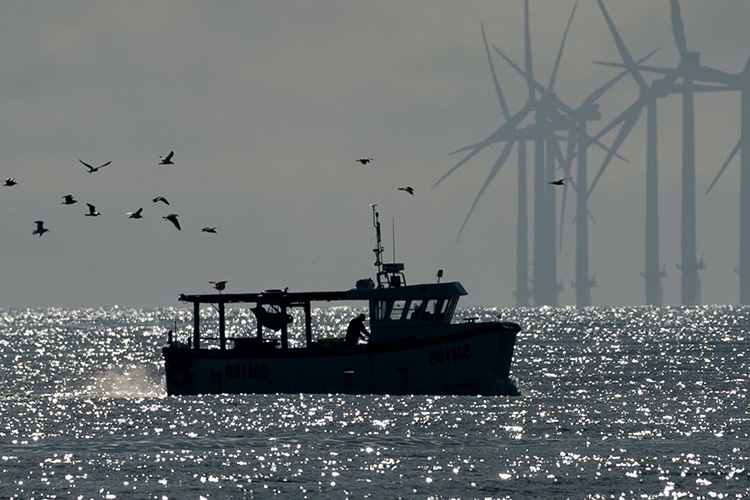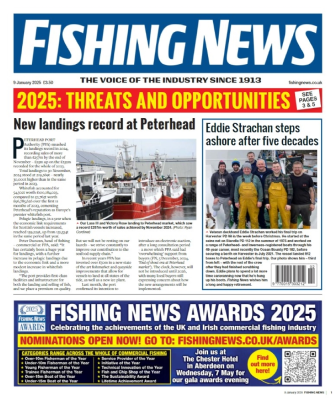New analysis aims to gauge the impacts of offshore wind on the fishing industry – and chart a way forward

By Dr Claire Szostek, Senior Ecosystem Services Scientist, Plymouth Marine Laboratory (PML)
Low-carbon renewable energy sources are essential for a sustainable future. Twenty years on from the first commercial offshore wind farm lease in the UK, the British Energy Security Strategy aims to provide 95% of electricity from low-carbon sources by 2030, with offshore wind farms having met half of that target in 2023.
However, while such a focus on renewables is urgently needed, marine urbanisation on this scale has significant implications for the environment, as well as other marine industries, and it is vital these are also taken into account.
Early in 2024, an online survey was distributed by researchers from Plymouth Marine Laboratory (PML) and the University of Aberdeen to the UK fishing industry, calling for views and experiences based on interactions with offshore wind farms around the British Isles.
We aimed to gain an in-depth understanding of the interactions occurring between the offshore wind and commercial fishing industries, and gauge how fishermen feel they are affected.
Over 50 responses were received – from England, Scotland, Wales, the Republic of Ireland, Northern Ireland, the Isle of Man and the Netherlands. A number of follow-up telephone interviews also took place. The respondents represent mobile and static gears, vessels of 5m to 50m in length, and 26 different target species.
The survey revealed ways in which fishermen across sectors responded to the presence of offshore wind farms, and how they have been impacted directly or indirectly. The major response to the presence of offshore wind farms was to fish in a different area (83% of respondents), often referred to as displacement of fishing effort. Less common responses were supplementing income in other ways, changing gear or target species, changing or modifying the vessel or leaving the fishing industry.
With future projections of offshore wind farm development, most respondents (83%) said they would consider leaving the fishing industry.
Due to displacement, many respondents said they had experienced a negative impact on catches and profitability, spatial competition with other fishing vessels, having to travel further to fish, and safety implications from having to steam through turbine arrays, particularly at night.
Indirect impacts include increased fuel costs (and carbon footprint), fatigue, lack of experience on unknown fishing grounds and loss of crew. Fishing vessels displaced in one location will relocate up or down the coast, creating a ripple effect of displacement and increased pressure on stocks in other areas. When asked about expected future impacts, many considered that such issues would increase and more fishermen would be affected.
Furthermore, while static gears are often portrayed as being more compatible for coexistence with offshore wind farms, mobile fishing gears are effectively excluded from wind farms (both fixed and floating) due to safety risks and logistical issues. Most fishermen are unsure of the implications of floating offshore wind farms, which will become much more common under current planned development.
At the same time, there were positive environmental outcomes reported. These included the artificial reef effect that occurs when human- made structures on the seabed provide 3D habitat and shelter for a range of species. Certain fish, such as cod and pouting, seem to aggregate around these structures, while others, including flatfish and whiting, show no evidence of this. Some respondents identified socio- economic benefits, and some lobster fishermen experienced improved catches inside fixed-base turbine arrays. However, the majority said they had experienced no benefits from offshore wind farms.
Multiple concerns were raised over compensation payments that are made by energy companies to fishermen in certain circumstances. Inequality between individual vessels and fleet sectors was reported, along with poor treatment of individuals during the process, and a requirement to sign non-disclosure documents.
Although three-quarters of respondents said they had been displaced by offshore wind farms in operation or under construction, only one-third (mostly under-15m vessels) said they had received compensation payments from energy companies, with mobile-gear fishers largely excluded from these payments.
Despite guidelines for compensation, it is apparent that a clear policy stance is required from the government, along with regulations to ensure that payments are adequate and fair for those impacted.
Other topics flagged for concern were the impacts from subsea cables on the ability to fish as normal, along with safety considerations and reported impacts on the behaviour of target species. For example, several respondents reported witnessing detrimental impacts on fish and shellfish after seismic surveys or construction activity.
The same impacts from offshore wind farms on the fishing industry have been reported in previous studies dating back almost 20 years, and development is now occurring at a rapid pace.
Fishermen face multiple challenges including spatial competition, spatial restrictions for conservation objectives, legislation, the after-effects of the Covid-19 pandemic and Brexit, and the right to fish commercially is being eroded where wind farms are sited over important fishing grounds. Therefore, many fishers are finding the financial viability of maintaining a vessel and retaining crew increasingly difficult.
If collaboration can be fostered, there is an opportunity to develop marine planning that reduces impacts on the fishing industry (see, for instance: bit.ly/49XLfX4), such as spacing between turbines or the orientation/micro-siting of turbines, and the orientation/ routing of cables can be designed to improve fishing access to sites.
In a scientific paper currently in review for publication, we have highlighted common impacts and responses from this recent study, and summarised how the fishing industry is being – and will continue to be – affected by the development of offshore wind farms.
Ways in which policy could evolve to mitigate impacts on commercial fishermen include better regulation, communication, forward planning and embedding guidelines into legislation. These measures are needed urgently to help reduce the inevitable impacts and support the fishing industry through the transition to renewable energy sources and the increasing development of the seabed.
On behalf of all the research team, I would like to thank all those who participated and provided valuable input into the surveys and interviews.


Fishing in a renewable future




